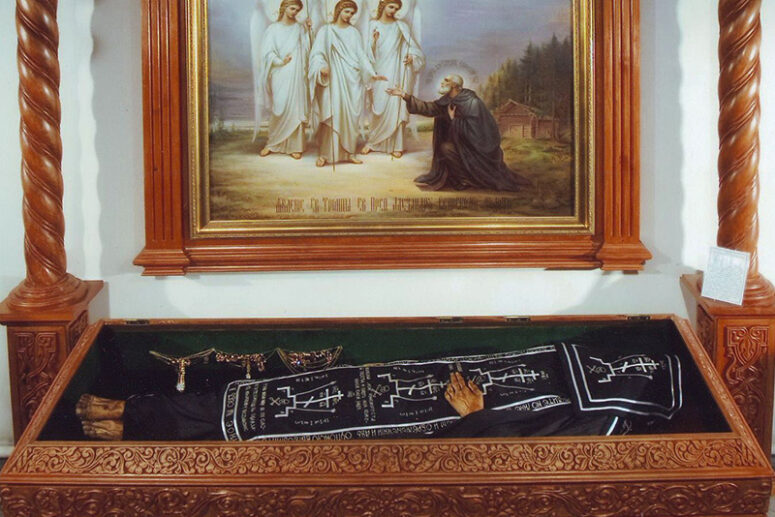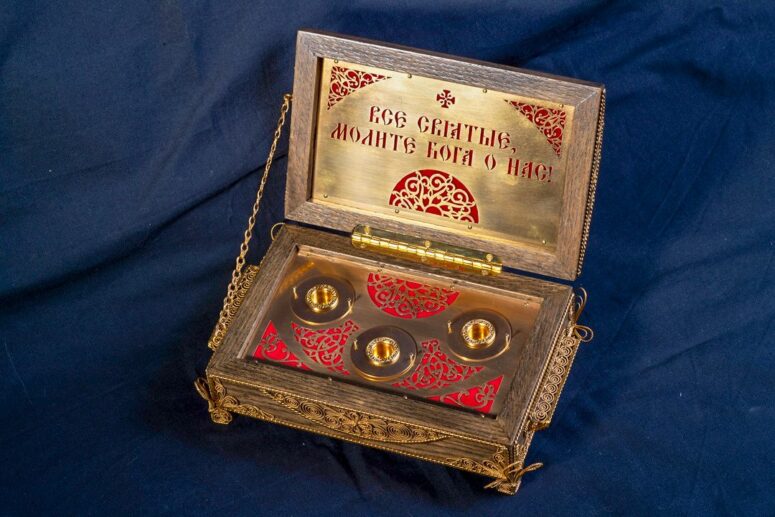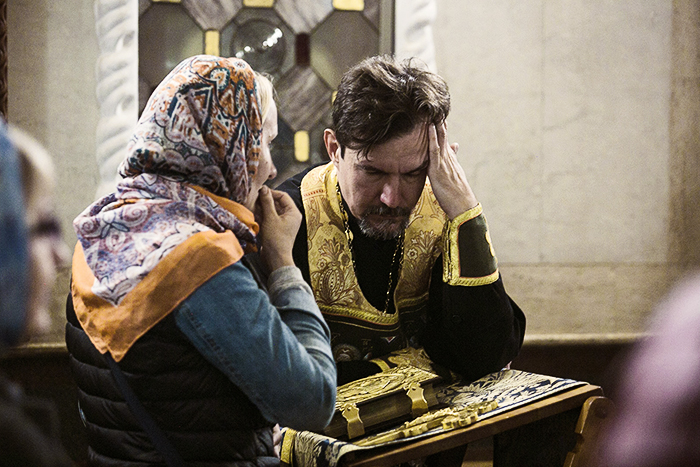
The practice of venerating relics of Christian saints and martyrs was established as early as in the first centuries after the birth of Christ. This is supported by historical evidence, such as the archaeological finds made in the catacombs, where early Christians were forced to hide from persecution. Liturgy was then served on martyrs’ tombs, elaborately decorated, as well as the relics that they contained.
By the end of the persecution against Christians, veneration of relics had already become firmly established in the practice of the Church. However, having a tomb of a saint in a church or a community was not always possible, which caused a need for new forms of venerating holy relics.
The tradition of serving Liturgy on relics of saints continues to this day. It is embodied in the practice of sewing a particle of relics into the antimension, and placing a reliquary box with relics under the altar table. There are also cases when divine services can be performed without relics.
In the 4-5 centuries, churches and chapels known as martyria began to be built on sites of dwelling, death or burial of some martyrs. According to the rule of the Carthage Council, their liturgical significance was equalled to that of relics. “May the memory of martyrs be commemorated in no place other than in presence of a martyr’s body, a part of relics, or, according to a reliable legend, a place of dwelling, property or suffering”.
Encolpia, also appearing in the 4th century, served as small reliquaries, holding particles of prosphora or relics. Most often, they were cruciform and depicted Christ or saints.
Wearing encolpia around the neck was a sole right of bishops. In the 18th century, encolpia became smaller, acquired a flat shape, and stopped serving as reliquaries, giving birth to pectoral crosses. However, on rare occasions, one can still find pectoral reliquary crosses, reminiscent of the ancient encolpia.
Relics of saints also used to be inserted into altar crosses. One of the most famous such reliquary-altar-crosses is the now-lost cross of St Euphrosyne of Polotsk (12th century). It contained fragments of the True Cross with drops of the blood of Christ, as well as a stone from the tomb of the Mother of God, a particle from the Holy Sepulchre, particles of the relics of Saints Stephen and Panteleimon and the blood of St Demetrius.
During the patriarchate of Nikon, the Russian Church began using crosses resembling the Calvary cross, displayed for public veneration in the church nave. Particles of relics were often inserted into these crosses. For example, the Kiy cross, currently located in St Sergius of Radonezh Church in Krapivniki, contains 108 particles of the relics of saints and 16 stones from the sites of biblical events.
There are frequent cases when entire bodies of saints are kept in churches or monasteries, just like in early Christian times. They are deposited in large reliquaries, resembling coffins in shape.
Often such shrines do not contain actual relics, but are symbolically placed over the burial place of a particular saint. In cases when a saint’s body rests in the reliquary, it is vested, according to his status or dignity.
Most often, only the reliquaries can be venerated today, although a practice used to exist when they were opened, and the relics were available for veneration. This practice is not spread, because it often led to cases when believers tried to help themselves to particles of relics. However, relics can still be made available for veneration on special request. They can also be opened on a saint’s feast day or after an akathist service.
Large reliquaries often represent true works of art. They are decorated with carvings, precious metals and stones and often have complex imagery. An example of such a shrine is the one of St Alexander Nevsky, currently kept in the Hermitage.

Parts of saints’ bodies are typically placed in small reliquary boxes, sometimes containing relics of several saints, as well as their personal belongings. The relics under the altar table are also kept in a reliquary box.
Smaller reliquaries can also be intricately decorated. Unlike their larger counterparts, which usually look like a coffin, they come in many different shapes. The most unusual reliquaries are common in the Catholic Church. Among them you can find reliquaries representing the saint, whose relics they contain.


The smallest particles of relics are usually kept in miniature relic-holders and placed on icons. Most often they have the shape of a cross, in the center of which there is a container for relics. The diameter of such a reliquary rarely exceeds 2-3 cm. They are placed directly on the icon, and the relics of the depicted saint are deposited in them. Due to their small size, such reliquaries are the least remarkable in terms of decoration.

Such a variety of reliquaries shows the Christians’ love for the departed saints and their special reverent attitude towards them. Although this reverence may seem somewhat strange to a secular person, it has a deep foundation in the Holy Scriptures and Sacred Tradition. Rejecting the Gnostic idea of the frailty of the body, the Church believes in the symphonic coexistence of body, soul and spirit. If a person is transformed in spirit, then he is also transformed in body. With that in mind, when we magnify the saints and their righteousness in prayers, the resting places of their bodies should also visibly express this magnificence.




